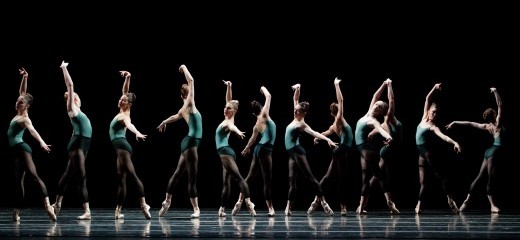
Photo: Alexander Iziliaev
Artifact: 1. that which is made from/out of art, 2. evidence of what came before.
By: Kirsten Kaschock
In Pennsylvania Ballet’s premiere performance of William Forsythe’s Artifact Suite—a redux of his 1984 full-length ode to ballet Artifact—dramatic elements (a woman in a historical dress, a man with a megaphone, text) have been excised. What remains is dance. Costumed in the neo-classical style (simple leotards, tights), the dancers exhibit extraordinary command of a movement vocabulary at times expanded, pushed off the vertical, but never departing far from 20th century ballet convention.
The curtain rises on two pas de deux vying for foreground and background. The competition is illusion. It’s simply the “problem” caused by Forsythe’s refusal to pare down the movement on stage to a single focal point. Three walls of dancers initially box in the duets. A conductor-figure (called Other Person in the program notes) stands center stage facing back. Her semaphore-like direction of the corps de ballet eventually ventures from simple geometric forms, becoming more gestural, individual, and impossible to imitate with exactitude—although the attempt by thirty-plus dancers at the end of a physically demanding work is thrilling.
That is: it was thrilling for me, and for a few others who jumped to their feet at the close of the work. The rest of the audience was more tempered in their response, and a handful of people left midway through.
Notions of ballet are highly individual. And everyone is right.
—William Forsythe*
During the first section of the suite, as the dancers move to “Chaconne” from J. S. Bach’s Partita No. 2 BVW 1004 in D-Minor, the curtain drops heavily at least six times. At first the audience titters, worried about technical difficulties. The second time, I hear some laughter. With each subsequent thud, I discern only grumbling—as if we are missing something other than dancers running frantically to their next tableau. Twenty-nine years after the first version of this piece premiered, the interruption of the traditional proscenium-framed formula still has the power to shock a ballet audience.
After the first section, performed in gold, the dancers return in aqua. The duets recede and larger group sections build one upon the next in waves. The music has also changed colors. The violin is gone, and
highly formalized improvisations based on the Bach partita and created by Forsythe’s rehearsal pianist, the late Eva Crossman-Hecht, now provide rhythmic and contrapuntal motivation for an ocean of dancers. Percussive walking and clapping periodically punctuate rushing port-de-bras and tidally recurring footwork patterns. In these moments, I feel strongly the inheritance of Balanchine: how the dancers seem almost visual representations of music, as in
Concerto Barocco. But Forsythe takes on more fields of action and interaction. Hands together, hands landing on thighs, heavy walking: suddenly, the idea of a visual score confronts the weighted, physical reality of these dancers. They don’t just represent music—their bodies can make it.
There is a simple and undeniable power in people moving as one. In contact improv class, a huddle of bodies may synchronize breath to achieve this sensation among its members. On stage in an abstract ballet, adherence to a choreographer’s vision—its several lines of action, its intensities, tempos, and nuances of phrasing—can realize the same affective result from the outside in. Each dancer reaching for this larger ideal promotes a sense of unified purpose, of symphonic effort. Pennsylvania Ballet, led by fearless partners Julie Diana and Ian Hussey, Lauren Fadeley and Francis Veyette, achieves just such a driving, driven place.
…but we all contribute to the idea of arabesque.
—William Forsythe
This joint striving is one of the strange pleasures
Artifact Suite provides. Strange because—potent and kinesthetic as the experience can be—it is also impossible for me to watch a troupe of dancers led through evenly-spaced angular unison (divided into separate regiments of action) without thinking of military training, or
group calisthenics on a grand scale. My feelings about the hierarchies necessary to accomplish such coordinated cohesion are ambivalent to say the least. Forsythe’s suite is bittersweet, functioning as both an homage to the sovereign nation of ballet and as a farewell to its decadences. Perhaps this embarrassment of riches (three dozen virtuosic dancers moving simultaneously and fiercely, impossible to attend to as individuals) is, well, a bit embarrassing.
When Caralin Curcio (the Other Person) walks finally forward, lower body quieted, her hands furiously articulating something too complex to be coherently amplified by the
human microphone of the corps de ballet, I am relieved. In the narrative I cannot help but create for myself, she represents the choreographic mind, and the other dancers are the seamless transition of that mind to the stage. I am reassured when her vocabulary surpasses their ability to replicate it, when they ever so slightly break ranks at the climactic moment of the work. Dancers are people. And in the work of this living master, continually pushing at the edges of form—that means that they are, that they must be, more than perfect embodiments of something else.
I belong to the class of people to whom ideas give pleasure.
—William Forsythe
What he said.
Forsythe & Kylián, Pennsylvania Ballet, Academy of Music, June 13-16.
(Also on the program were the Pennsylvania Ballet premiere of Jiri Kylián’s Forgotten Land, and World Premiere of At Various Points by Matthew Neenan.)
By Kirsten Kaschock
June 18, 2013

